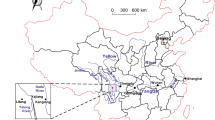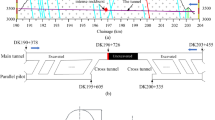Abstract
Shirengou iron mine in Hebei Province, China is now under transition from open pit to underground mining. During this process, the unstable failure risk of crown pillar is growing as a result of underground mining, fault activation and water seepage. To monitor the stability of the crown pillar, a microseismic monitoring system was equipped in 2006. Based on temporal and spatial distribution of microseismic events and deformation mechanism, it was found that it is the propagation of the buried fault F15 that causes the failure of the crown pillar, resulting in increased water seeping into the underground drifts. By analyzing the temporal changes in multiple microseismic parameters during the fracture process of the crown pillar, it was found that several distinct abnormalities in the microseismic data such as a rapid decrease in the b value, a sharp increase in energy release, an abnormal increase in apparent stress and a low dominant frequency, could be judged as the signal of an increasing risk. Therefore, the microseismic monitoring has been proven to be a suitable method for understanding damage and fracture process of the crown pillar during the transition from open pit to underground mining.











Similar content being viewed by others
References
Aminzadeh F, Tafti TA, Maity D (2013) An integrated methodology for sub-surface fracture characterization using microseismic data: a case study at the NW Geysers. Comput Geosci 54:39–49
Amitrano D (2003) Brittle-ductile transition and associated seismicity: experimental and numerical studies and relationship with the b value. J Geophys Res 108:2044–2059
Carter TG (1992) A new approach to surface crown pillar design. 16th Canadian rock mechanics symposium. Laurentian University, Sudbury, pp 75–84
Chen J, Guo D, Li J (2003) Optimization principle of combined surface and underground mining and its applications. J Cent South Univ Technol 10:222–225
Elmo D, Vyazmensky A, Stead D, Rance JR (2007) A hybrid FEM/DEM approach to model the interaction between open-pit and underground block-caving mining. In: 1st Canada/United states rock mechanics symposium, Vancouver, Canada, 2007, pp 1287–1294
Gale WJ, Heasley KA, Iannacchione AT et al (2001) Rock damage characterisation from microseismic monitoring. In: Elsworth D, Tinucci JP, Heasley KA (eds) Rock mechanics in the national interest. Swets and Zeitlinger, Washington, DC, pp 1313–1320
Ge MC (2005) Efficient mine microseismic monitoring. Int J Coal Geol 64:44–56
Gutenberg B, Richter CF (1954) Seismicity of the earth and associated phenomena, 2nd edn. Princeton University, Princeton
Hutchinson DJ, Phillips C, Cascante G (2002) Risk considerations for crown pillar stability assessment for mine closure planning. Geotech Geol Eng 20:41–63
Iannacchione AT, Bajpayee TS (2005) Forecasting roof falls with monitoring technologies-a look at the Moonee Colliery experience. In: 24th Int. Conf. Ground Control Min, Morgantown, 2005, pp 44–51
Lei XL (2006) Typical phases of pre-failure damage in granitic rocks under differential compression, vol 261. Geological Society, London, pp 11–29
Li T, Mei TT, Sun XH et al (2013a) A study on a water-inrush incident at Laohutai coalmine. Int J Rock Mech Min Sci 59:151–159
Li XB, Li DY, Liu ZX, Zhao GY, Wang WH (2013b) Determination of the minimum thickness of crown pillar for safe exploitation of a subsea gold mine based on numerical modeling. Int J Rock Mech Min Sci 57:42–56
Liu JP, Feng XT, Li YH, Xu SD, Sheng Y (2013) Studies on temporal and spatial variation of microseismic activities in a deep metal mine. Int J Rock Mech Min Sci 60:171–179
Ma SL, He CR (2001) Period doubling as a result of slip complexities in sliding surfaces with strength heterogeneity. Tectonophysics 337:135–145
Mendecki A (1997) Seismic monitoring in mines. Chapman and Hall, London
Nan SQ (2007) Investigation on the stability of boundary pillar and mining technology in transition open-pit to underground mine. Northeastern University, China
Santis AD, Cianchini G, Favali P, Beranzoli L, Boschi E (2011) The Gutenberg–Richter law and entropy of earthquakes: two case studies in central Italy. Bull Seismol Soc Am 101:1386–1395
Schorlemmer D, Wiemer S, Wyss M (2005) Variations in earthquake size distribution across different stress regimes. Nature 437:539–542
Srinivasan C, Arora SK, Benady S (1999) Precursory monitoring of impending rock bursts in Kolar gold mines from microseismic emissions at deeper levels. Int J Rock Mech Min Sci 36:941–948
Szwedzicki T (2003) Rock mass behaviour prior to failure. Int J Rock Mech Min Sci 40:573–584
Tawadrous AS, Katsabanis PD (2007) Prediction of surface crown pillar stability using artificial neural networks. Int J Numer Anal Meth Geomech 31:917–931
Tezuka K, Niitsuma H (2000) Stress estimated using microseismic clusters and its relationship to the fracture system of the Hijiori hot dry rock reservoir. Eng Geol 56:47–62
Xu NW, Tang CA, Li LC et al (2011) Microseismic monitoring and stability analysis of the left bank slope in Jinping first stage hydropower station in southwestern China. Int J Rock Mech Min Sci 48:950–963
Acknowledgments
This work was supported by the Basic Research Program (973) of China (No. 2013CB227902), the Fundamental Research Funds for the Central Universities (N130501002, N120601002) and the National Natural Science Foundation of China (51174045, 51034001, 41172265, 51404067).
Author information
Authors and Affiliations
Corresponding author
Rights and permissions
About this article
Cite this article
Zhang, P., Yang, T., Yu, Q. et al. Microseismicity Induced by Fault Activation During the Fracture Process of a Crown Pillar. Rock Mech Rock Eng 48, 1673–1682 (2015). https://doi.org/10.1007/s00603-014-0659-9
Received:
Accepted:
Published:
Issue Date:
DOI: https://doi.org/10.1007/s00603-014-0659-9




